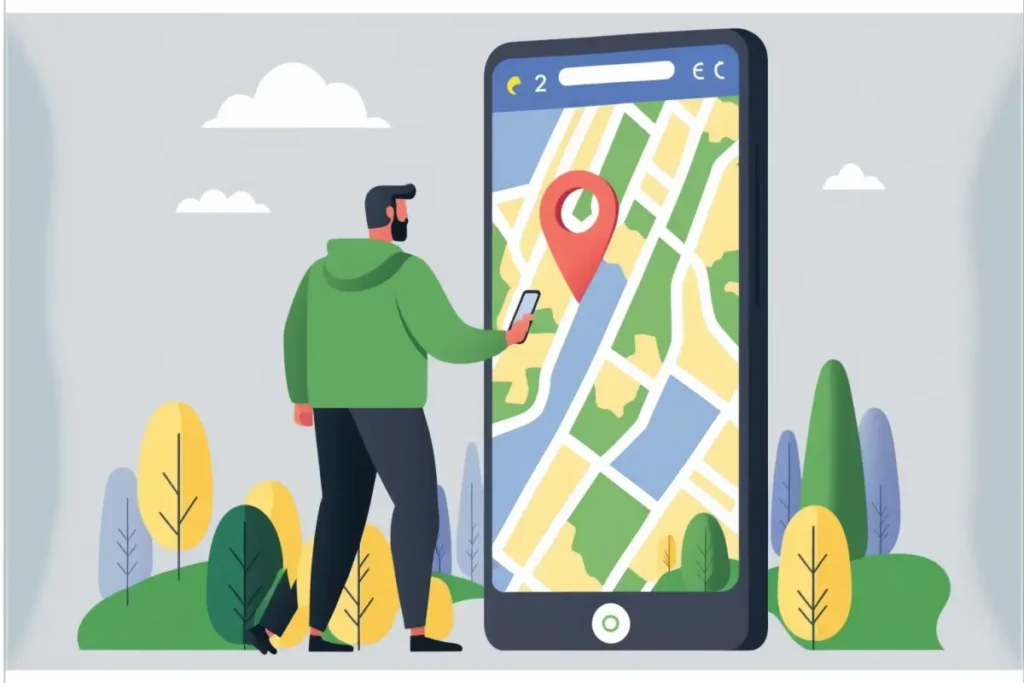As a small business owner or marketer, deciphering how these two mechanisms work can be the key to amplifying your reach and driving more customers through your doors.
Google Maps ranking primarily focuses on local searches, guiding users directly to businesses in their vicinity. In contrast, organic search rankings encompass broader queries that might not lead to immediate purchases. For small business owners operating with limited resources, balancing these two strategies can seem daunting. However, mastering both can significantly enhance your brand’s presence online, ensuring you capture attention in every relevant channel. Join us as we dive deeper into each area and explore how you can strategically position your business for success in this dynamic landscape. Your journey towards optimized visibility begins now!
Understanding Google Maps Ranking
Google Maps ranking refers to how businesses are displayed within Google Maps when users search for local services or products. This ranking is crucial, especially for small businesses looking to attract nearby customers. A high position on the map can significantly increase foot traffic and drive more inquiries, making it a vital component of local marketing strategies.
When potential customers search for phrases like “best coffee shop near me” or “plumber in [City Name],” Google prioritizes businesses based on relevance, distance, and prominence—factors that stem from both user engagement and local SEO practices.
Several key factors influence Google Maps rankings. First, the accuracy and completeness of your business listing play a substantial role; this includes ensuring that your address, phone number, operating hours, and services are fully updated. Second, customer reviews can make a big impact — positive ratings not only enhance your visibility but also build trust among potential customers. Businesses that encourage satisfied clients to leave feedback often see significant improvements in their mapping results. Lastly, geographic relevance comes into play; if you’re searching for a service provider like an electrician close to you, those with higher proximity will appear at the top of the rankings.
Local SEO serves as the backbone supporting Google Maps visibility by optimizing various components of your online presence to cater specifically to your community. Incorporating relevant geo-targeted keywords into your website content helps search engines associate your business with localized searches effectively. For instance, if you’re a bakery in Austin, including phrases such as “Austin bakery” within your website content allows search algorithms to place you higher not just in organic search results but also on maps when someone searches for bakeries in that area.
In summary, understanding Google Maps ranking is essential for any small business owner aiming to optimize their digital marketing strategy. By focusing on accurate listings and actively engaging with customer feedback while leveraging local SEO principles, businesses can enhance their visibility in an increasingly competitive landscape—a necessity as consumers turn more frequently to their mobile devices for location-based queries.
What is Organic Search?
Organic search refers to the process by which search engines display unpaid listings in response to user queries, utilizing a series of algorithms designed to evaluate and rank content. Unlike Google Maps ranking, which focuses primarily on local relevance and proximity, organic search results hinge on various traditional SEO components such as keyword usage, website structure, credible backlinks, and overall content quality.
Businesses aiming for higher rankings must strategically optimize their web pages to ensure they meet both user intent and algorithmic requirements. For instance, if a local bakery optimizes its website around keywords like “freshly baked bread” or “artisan pastries,” it stands a better chance of appearing in the top results when users are searching for those specific terms.
The determination of organic search rankings is driven by complex algorithms that consider multiple factors—each weighed differently based on its significance in establishing authority and relevance. Key elements include the website’s domain credibility, page load speed, mobile-friendliness, and user engagement metrics such as click-through rates and bounce rates. An example of this can be observed with e-commerce sites; those offering seamless navigation experiences and fast loading times demonstrate higher retention rates than those not optimized for user experience. This ultimately influences their visibility within the competitive realm of online searches.
Keyword research plays a foundational role in developing effective organic search strategies. Businesses must identify relevant keywords that potential customers are using while ensuring these keywords have an optimal balance of search volume and competition level.
This act involves utilizing tools like Google Keyword Planner or SEMrush to uncover trending terms effectively linked to one’s offerings. A simple yet powerful tactic could involve local coffee shops researching phrases like “best coffee near me” or “organic coffee shop,” allowing them to cater their content specifically to tap into nearby consumers’ interests—substantially boosting their online visibility.
In sum, distinguishing organic search from Google Maps ranking reveals a more expansive landscape where broader audiences can engage with businesses across various platforms. The nuances between appealing locally through geographical searches versus reaching out on a global scale through organic listings reflect diverse marketing needs—and underscore why mastering both tactics can propel overall online visibility for small business owners looking to thrive in today’s digital arena.
Key Differences Between Google Maps Ranking and Organic Search
When it comes to user intent, the distinction between searching via Google Maps and traditional web pages is significant. Users typically turn to Google Maps with a clear goal in mind: they want local solutions, such as nearby restaurants, service providers, or retail stores. For example, if someone searches for “Italian restaurant near me,” they’re expecting immediate and tangible options that cater to their location. In contrast, an organic search like “best Italian recipes” may attract users looking for broader information or inspiration that doesn’t necessarily result in an immediate purchase or visit. This fundamental difference speaks to why optimizing for Google Maps ranking is paramount for businesses primarily serving local communities.
Different metrics also come into play when assessing performance across these two platforms. For instance, Google Maps ranking heavily relies on factors such as proximity, relevance, and prominence within the local area—often measured through reviews, ratings, and the completeness of business profiles. Businesses aiming for visibility on Google Maps should focus on accumulating positive reviews and correctly categorizing their services. On the other hand, organic search rankings prioritize keyword optimization, backlinks, and content quality among many traditional SEO considerations. Herein lies the challenge; while both methods demand performance tracking through analytics tools like Google Analytics or Search Console, the specific criteria for success differ fundamentally across each platform.
Moreover, accessibility to diverse audience segments varies considerably based on map visibility versus web presence. Google Maps tends to attract more immediate users seeking quick solutions who are often ready-to-commit customers—think about someone driving around needing a last-minute gift store compared to someone leisurely browsing blog posts about gifting ideas online. For small businesses targeting a local demographic (like hair salons or plumbing services), being prominent on Google Maps can drive foot traffic effectively. Conversely, companies selling products nationally may find greater gain in achieving higher ranks in organic search results since their customer base spans far beyond geographical limitations.
Understanding these nuances allows small business owners and marketers not only to tailor their strategies accordingly but also assess where they should focus their energy most efficiently. Balancing your approach in prioritizing both avenues ensures you cater adequately to varying consumer needs—growing your overall reach while enhancing visibility within your community!
Benefits of Optimizing Google Maps Ranking
Optimizing your Google Maps ranking can have an immensely positive impact on your small business’s visibility and foot traffic. With the rise of location-based searches, more consumers are turning to Google Maps to find services and products in their immediate vicinity. For instance, a local coffee shop that appears prominently in Google’s Map results is far more likely to attract walk-in customers than one that does not. By claiming and optimizing your Google My Business profile, you can ensure that your business stands out in a crowded marketplace, increasing the likelihood of spontaneous visits from nearby potential clients.
Building trust with customers is another significant benefit of optimizing your presence on Google Maps. The platform allows users to leave reviews and rate businesses they’ve interacted with, which can hugely influence new customers’ decisions. For example, if a family looking for a pediatrician sees that “Happy Kids Pediatrics” has outstanding reviews and high ratings on Google Maps, they are much more inclined to choose that medical provider over others with little or no feedback. Positive reviews serve as virtual word-of-mouth testimonials that enhance credibility and foster trust within the community.
Additionally, optimizing for Google Maps provides quick access to essential business information right when potential customers are searching for it most. An accurately filled-out Google My Business profile ensures vital details — such as address, phone number, hours of operation, and services offered — are readily available at users’ fingertips. This convenience alleviates potential frustration for anyone attempting to reach you; after all, nothing deters would-be patrons faster than inaccurate or outdated information. Quick access makes conversion seamless and encourages repeat business: A customer who finds what they need efficiently is likely to return.
In conclusion, there’s no denying the advantages of focusing on improving your Google Maps ranking alongside maintaining overall online visibility. Enhanced local visibility leads directly to increased foot traffic while earning consumer trust through reviews bolsters long-term relationships with existing clients—making it imperative for any small business aiming for sustained growth in today’s competitive market landscape.
Advantages of Focusing on Organic Search Rankings
Focusing on organic search rankings provides small businesses with long-term sustainability that far outstrips short-lived paid advertising options. While pay-per-click campaigns can generate immediate traffic and visibility, they often come at a high cost and stop yielding returns the moment you cease your spending. In contrast, a well-optimized website targeting relevant keywords can lead to consistent organic traffic over time. For example, a local bakery investing in creating quality blog content about baking tips may attract visitors well beyond their immediate area, gradually building a loyal online following.
Moreover, organic search allows businesses to reach a broader audience beyond just local searches. While Google Maps ranking is crucial for driving foot traffic locally, optimizing for organic search expands your potential customer base significantly. A company offering eco-friendly cleaning solutions could create content targeting not only local keywords but also wide-ranging topics like home maintenance tips or sustainable living practices. This strategy effectively draws in environmentally conscious consumers from different geographical areas who might be interested in ordering products online, thus diversifying their revenue streams.
The impact of strong organic search rankings goes beyond mere metrics—it plays an essential role in establishing brand authority and credibility over time. When your website consistently appears at the top of search results for related inquiries, it sends a signal to users that you are an industry leader. For instance, if a fitness studio frequently ranks high with informative articles about health and wellness trends, potential clients are more likely to trust this establishment over competitors vying for their attention solely through ads or maps placements. Brand loyalty often begins with perceived expertise; therefore, investing effort into cultivating these rankings pays off exponentially.
In conclusion, while Google Maps ranking serves as an effective tool for attracting local clientele, focusing on organic search opens up avenues that contribute to both immediate growth and sustained success over the long term. By leveraging content marketing strategies that bolster visibility while fostering brand integrity and outreach capabilities, businesses can navigate the complex digital landscape with resilience and effectiveness.
Strategies for Balancing Both Efforts
To effectively balance your Google Maps ranking and organic search efforts, it’s essential to optimize both profiles simultaneously. Start with a complete and up-to-date Google My Business profile by ensuring your contact information, operating hours, and business categories are accurate. Use high-quality images that showcase your products and services to attract local customers. On the other hand, make sure your website is not just user-friendly but also optimized for mobile users; since many local searches happen on smartphones, having consistent NAP (Name, Address, Phone) information across both platforms is crucial for enhancing visibility.
Integrating content strategies can significantly benefit your overall online presence. For instance, if you run a local bakery, create blog posts about seasonal offerings or recipes while making sure to link those posts back to specific pages on your Google My Business profile. This not only helps in driving traffic from organic search but reinforces relevancy in local searches when prospective customers look for related terms like “best cupcake near me.” Incorporate local keywords naturally into both website content and GMB descriptions to ensure optimal reach among different audience segments looking for relevant services.
Tracking performance using analytics tools will allow you to measure success across both channels effectively. Tools like Google Analytics can provide insights into website traffic coming from various sources, including direct referrals from any calls-to-action linked in your Google Maps listing. Consider setting specific goals within these analytics platforms—be it an increase in foot traffic driven by map visibility or higher engagement rates on web content—to refine strategies as needed subsequently.
By aligning the focus of both platforms through these tactics, small businesses can maximize their digital footprint. Embracing dual optimization not only enhances immediate visibility but also builds a cohesive brand narrative that resonates with both local audiences searching on maps and wider markets interacting through organic search results. The synergy created by balancing both efforts will ultimately lead to more reliable customer engagement and increased revenue potential.
Common Challenges Faced by Businesses
In the ever-changing landscape of digital marketing, small businesses often encounter considerable challenges when trying to enhance their visibility through both Google Maps ranking and organic search. One main hurdle is competition; as more businesses recognize the significance of local SEO and search engine optimization, the race to secure a prime position in Google Maps or atop organic search results intensifies. For instance, a quaint coffee shop may find itself competing with not just other nearby cafes but also large chains that throw substantial money into advertising and optimization efforts. This competitive atmosphere requires businesses to consistently refine their strategies to stand out.
Another prevalent challenge is maintaining accurate and up-to-date information across multiple platforms. When a business updates its operating hours, new offerings, or even its address, ensuring that all listings are current becomes paramount. Inconsistent information can lead potential customers to frustration or mistrust — imagine someone heading to dinner at a locally-reviewed restaurant only to find it closed because the hours listed on Google were outdated. To combat this, businesses must implement regular audits of their online presence, making adjustments where necessary so that they reflect correct details across both their Google Maps profile and website.
Furthermore, understanding evolving algorithms set forth by Google adds another layer of complexity for small business owners. Google’s algorithms frequently change in order to improve user experience and deliver more relevant results based on shifting consumer behavior. These changes can affect ranking factors greatly; therefore, staying ahead means keeping abreast of industry trends and best practices in SEO strategies. For example, if greater emphasis shifts towards local reviews affecting rankings due to an algorithm update, businesses must adapt quickly – encouraging satisfied customers to leave positive feedback could significantly bolster their visibility on both fronts.
Navigating these challenges requires dedicated effort and adaptive strategies from small business owners and marketers alike. By embracing proactive measures—like regular content updates, thorough competitor research, and active engagement with the community—businesses can maintain a robust presence both on Google Maps and in organic search results despite these ongoing hurdles. Ultimately, success hinges upon recognizing that while the demands may be high, so too are the rewards for those who rise to meet them effectively.
Case Studies: Success Stories from Local Businesses
In today’s competitive digital landscape, both Google Maps ranking and organic search can make or break a small business. Consider the example of “Bella’s Bakery,” a local pastry shop that turned its fortunes around through strategic use of Google Maps. By claiming and optimizing their Google My Business profile, Bella’s Bakery improved its visibility in local searches significantly. They added essential information like hours of operation, contact details, and enticing images of their baked goods. As a result, customers noticed increased foot traffic—often mentioning how they discovered the bakery while searching for “best pastries near me.” This boost not only enhanced direct sales but also fostered an enriching user experience that led to numerous positive reviews.
Another compelling story comes from “Tech Haven,” a home repair service that effectively leveraged organic search strategies to increase their clientele. Understanding the importance of keyword research allowed them to produce valuable blog content addressing common tech problems faced by homeowners. Each article was optimized with relevant keywords such as “local computer repair” and “smartphone troubleshooting.” Their efforts resulted in higher rankings on search engine results pages (SERPs), thus driving significant traffic to their website over time. This long-term strategy helped establish Tech Haven as an authority in the market, fostering trust among both existing and potential clients.
By examining these case studies, it becomes evident that when businesses invest time into optimizing for both Google Maps ranking and organic search simultaneously, they reap substantial benefits. Bella’s Bakery demonstrated how a focus on local SEO could enhance customer engagement through immediate access to pertinent information while improving user experience via vibrant visuals. Conversely, Tech Haven illustrated how quality content geared towards solving consumer problems can elevate brand credibility organically over time. Both approaches serve distinct purposes yet are intertwined: better visibility fosters more customer interactions, thereby contributing to sustained success in various forms.
Ultimately, these examples underscore that small businesses are thriving by harmonizing their strategies across platforms—maximizing exposure whether customers are seeking directions to a physical storefront or answers online before making a purchase decision. As such, leveraging both Google Maps ranking and organic search optimization is not just beneficial; it’s essential for holistic growth in today’s digital marketplace.
Finding the Right Balance for Success
In today’s competitive digital landscape, both Google Maps ranking and organic search play crucial roles in driving visibility for small businesses. Each platform caters to different user intents and audience segments, making it essential to optimize for both. Ignoring one can limit your reach and potential customer base.
To truly succeed, businesses should adopt a balanced approach. Invest time and resources into enhancing your Google Maps ranking while simultaneously refining your organic search strategies. This dual focus will ensure you capture more opportunities, leading to greater online visibility and ultimately driving growth. Prioritizing optimization in both areas will set you apart from competitors and attract a broader range of customers to your business.




